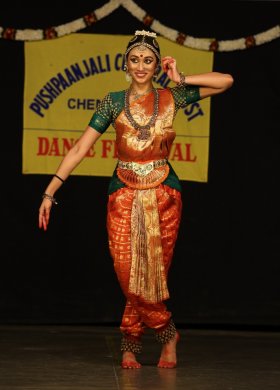 |
 |
Shreyasi Gopinath: A delightful artist to watch November 24, 2016  Shreyasi Gopinath had her initial training and arangetram under Guru
Saroja Vaidyanathan and later went on to do her post diploma at
Kalakshetra, Chennai. Currently, under the tutelage of Guru Jamuna
Krishnan and Ragini Chandrashekar, she gave a graceful and delectable
recital in Mylapore Fine Arts, Chennai, on 8th of November before an
appreciative audience, critics and connoisseurs. Shreyasi Gopinath had her initial training and arangetram under Guru
Saroja Vaidyanathan and later went on to do her post diploma at
Kalakshetra, Chennai. Currently, under the tutelage of Guru Jamuna
Krishnan and Ragini Chandrashekar, she gave a graceful and delectable
recital in Mylapore Fine Arts, Chennai, on 8th of November before an
appreciative audience, critics and connoisseurs. Shreyasi commenced her recital with Oothukadu Venkatakavi's "Aananda Nartana Ganapathi" in raga Nattai set to adi talam where all the facets of Lord Ganesha were beautifully portrayed by her with an emphasis on Nartana Ganapathi. Shreyasi immediately took up the main item of the evening on Lord Krishna in ragam Charukesi, talam adi, composed by violin maestro Lalgudi G Jayaraman. This item has gained much popularity among the dance artists and this piece is none other than "Innum en manam ariyadavar." The nayika tells Lord Krishna, "Why have you still not understood the pangs of my heart," and finally calls him "Manna Kamalakanna Manivanna" and longs for union with Krishna. The sanchari depicting Andal preparing the garland, wearing it and attracting Krishna, and the present nayika complaining to Lord Krishna that under similar circumstances, Krishna who went to Andal and graced her was not showing his presence to her, was very interestingly brought to light by Shreyasi. The choreography by Ragini Chandrashekar was impressive and it was a double delight to watch Shreyasi executing the jathis meticulously to the perfect percussion rendition of M.V. Chandrashekar. The araimandi poses were authentic. The first line of the charanam "Kuzhal udum arzhagay kanna kurai thirayo" was interspersed with Mel Kala jathi which drew a big round of applause when Shreyasi executed it. Her abhinaya for the line "Venney unnum vaayaa" ending with "Aaruire va Aalava" was finely portrayed. Shreyasi is an accomplished dancer who could have danced for a more speedy kalapramanam which would have further enhanced the effect of the recital even though the present kalapramanam or speed was, by and large, generally satisfactory. The post varnam session included a Meera bhajan in Sindhu Bhairavi, "Piya te kahan aa gayo nehara laga" which meant "Oh beloved, where have you gone after showing me your tender love and being with me," choreographed by Guru Jamuna Krishnan and was a delight to watch. The next piece was the Paras javali where one remembers the famous Jayamma singing for Balasaraswathi, "Veenula kimpuga veenavayinchi aliveni ne pada sabasinchude" meaning "While playing the veena, my beloved was so impressed that he said Sabhash." Right from the line "Smarasundaranguni," Shreyasi exhibited her maturity and the abhinaya for this piece earned the appreciation of the audience. Shreyasi concluded her recital with Dhandayuthapani Pillai's Ragamalika thillana commencing with Hindolam followed by Kaanada, Mohanam and Kalyani. The traditional attami and the jathis drew repeated applause from the audience and it was a pleasure to watch Shreyasi in this thillana. The accompanying artist Satish Venkatesan with his bhava laden vocal support, violin by Easwar Ramakrishnan, percussion by M.V. Chandrashekar added colour to Shreyasi's recital. Ragini Chandrashekar wielded the cymbals very effectively. Shreyasi is a graceful and delightful artiste with a very good stage presence and poise and she will be an invaluable addition to the galaxy of upcoming artistes, one would long to watch. |